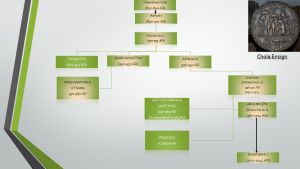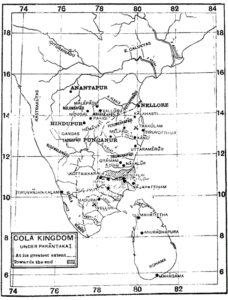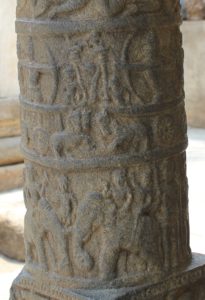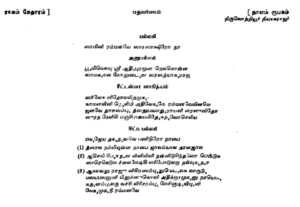[simple-author-box]
Prologue & A Prelude:

Ragas like Saranganatta, Desakshi, Samantha and Malavasri once upon time ruled the roost but today lie forgotten and unsung. Malavasri is a raga in which both Tyagaraja and Muthusvami Dikshita have composed. This blog post is to document the history of the raga in brief and introduce Dikshita’s composition to the reader of this blog.
But before that, is a prelude. The year was 1945, when the Second World War was winding down, with the day being March 25th, a Sunday. If one had tuned into the All India Radio Madras 1 Station at 10PM that day, after the rendering of the popular “ Nee Inrangayenil” by the young and sprightly M S Subbulakshmi, the listener would have next heard the kriti of Tyagaraja in the raga Malavasri (“Evarunnaru brova”) played from the vinyl record rendered by the then 26 year old D K Pattammal in her inimitable style, followed by Dikshita’s “Manasa Guruguha rupam” in Anandabhairavi – vide the extract of the day’s broadcast schedule from the “Indian Listener” pinned as the header to this post.
The same recording made by her close to 90 years ago can be heard here:
Yet another is a dance piece for listening- Kubera Stuti- in tisra eka tala set in the raga Malavasri.
The raga Malavasri belongs to the 22nd Mela (Kharaharapriya/Sriraga) taking the following svaras/murrcanas in its ascent and descent, according to the Sangita Sampradaya Pradarshini (SSP).
Arohana: S G2 G2 M1 P N2 D2 N2 S
Arohana: S N2 N2 D2 P M1 P N2 D2 M1 M1 G2 S
Mark the emphasis on the gandhara, madhyama and nishadha notes in the progression. This raga is an oddity for more than one reason for it also incorporates a few now-lost 18th century raga architectural attributes. While Natta, Gaula, Arabhi, Varali and Sri were the traditional ghana ragas (pancakam) of the first category, the ragas Reetigaula, Narayanagaula, , Bhauli, Malavasri and Saranganatta are the constituents of the dviteeya ghana pancakam.
Historical Background to the Raga:
The raga right through history has been recorded by musicologists and with the advent of the mela scheme, Venkatamakhin (1620 CE) as well as Shaji (circa 1700 CE) and Tulaja (circa 1732 CE), placed the raga as a shadava raga skipping rishabha altogether under Sriraga mela. And the raga is documented as-is in the Ragalakshanam of Muddu Venkatamakhin (circa 1750). Older texts while helping in validating the broad lakshanas of ragas, do not provide us with the intricate details or compositions and we are left to rely on the Sangita Sampradaya Pradarshini (SSP) of Subbarama Dikshita which details this raga for our benefit.
The SSP’s narrative provides us with this nominal raga structure for us.
Arohana: S G2 G2 M1 P N2 N2 D2 N2 S
Arohana: S N2 N2 D2 P M1 P N2 D2 M1 M1 G2 S
Attention is invited to the vakra dhaivatha in the arohana and the SNDPM, SNDNPM, SNDNPM combinations that occur in the descent. Further Subbarama Dikshita asserts on the authority of the older texts that there are no sancaras beyond the madhya stayi. In fact, Muthusvami Dikshita’s kriti provided as an exemplar goes one step further as the raga is dealt with only between madhya gandhara and tara pancama, with no sancaras below.
The SSP documents the following compositions as exemplars of the raga, none of which are in currency on the modern concert stage.
- “ Mangalambayai Namaste” of Muthusvami Dikshita in misra jhampa tala
- “Devi Sathatham” of Krishnasvami Ayya in Matya capu tala – the musical setting perhaps being done by Subbarama Dikshita himself
- “Indha perumai” – a padam in Tamil by Mukkupulavar in misra eka tala – the sahitya being that of the Ettayapuram Court poet and the musical setting likely of Balasvami Dikshita
The SSP apart from documenting the lakshya gitam ascribing it to Venkatamakhin as authority for the raga’s grammar also documents a unique gitam commencing as “manmadha naLa” called as “mukta-pada-grastham” whereby the ending syllabic constituent unit of the previous sahitya section becomes the first syllabic constituent of the succeeding sahitya portion. (andhadhi). Much like the Narayanagaula gitam documented in the SSP, this gitam must have been in currency and must have been a popular composition. It must be emphasized that gitas or gita prabhandas were the concise repositories of a raga’s lakshanas, encapsulating pithily the set of all possible svara combinations or murrcanas of the raga, akin to how we treat the varna in modern days.
A perusal of the said gita offers us vital clues as to this raga’s lakshana:
- The raga delineated spans the madhya sadja to the tara madhyama. There are no mandhara stayi phrases in the gita.
- The gita is divided into two parts – the first one being the dhruvam – the so-called opening refrain or what we today call as the pallavi. The second is the javada or the so called anupallavi part which loops back to the dhruvam or the refrain.
- Nishadha followed by the madhyama is found greatly emphasized by their repeated usage both in the dheergha and janta varieties.
- The salient arohana and avarohana murrcanas found are as under:
- Madhya stayi- ascent- SGGM-MMP-MPNNDN-NDNS
- Madhya stayi – descent: -SNS-SNNDPMP- SNDP-SNDNPN-MNDMGS-SNDNPNDMGS-PMGS
- Tara stayi – S,GS- MMGS-SMGS-MGSMGS-
Apart from the SSP two other documented sources of this raga from olden times even antecedent to the SSP are as under:
- “manmadha nala” the gitam in Malavasri found in the SSP is also published in Pallavi Svara Kalpavalli (published in 1900 CE) by Tiruvottriyur Tyagier. There are a few variations here and there save for one crucial aspect which is that in one place the mandhara nishadha is touched.
- “Sri Ramani kucakumkuma” – a ragamalika gitam of 32 ragas in Dhruva tala of which Malavsri is one is found published in “Sangeetha Sarvaartha Sara Sangrahamu” of Veena Ramanujacharya (1873 CE). The sahitya and the corresponding musical notation which runs for one avarta of tala is as under:
| 1 | 2 | 3 | 4 | 5 | 6 |
| S | , | M | M | G | S |
| gA | . | . | . | ya | ka |
| N | S | N | D | ||
| pa | . | rA | . | ||
| N | N | D | M | ||
| ya | nu | rE | . |
The notation in italics is the tara sancara notes of the raga. This brief snippet of the raga encompasses madhya stayi madhyama to tara stayi madhyama, emphasizing nishadha madhyama notes, corresponding to the treatment of the raga in “Mangalambayai Namaste” as we will see shortly. And while dhaivatha is vakra in the arohana, it is more seen vakra in the avarohana as well though a lineal SNDP is not forbidden. Vakra sancaras are de rigueur in this raga, which by incorporating multiple flows of murccanas follows the classical 18th century raga architecture.
It has to be pointed out that the raga’s lakshana as embodied in the SSP fully accords with the musical history right from the times of Venkatamakhin staying under the Sri raga mela and omitting rishabha. Both Sahaji and Tulaja in their works reinforce the same lakshana for the raga. Even the Sangraha Cudamani, the lexicon of the ragas of compositions of Tyagaraja omits rishaba in its structure and provides roughly the same arohana-avarohana krama for the raga.
And off course all musical texts are unanimous as to the rishabha being omitted and the raga being a upanga raga under 22nd mela.
“Mangalambayai Namaste” of Muthusvami Dikshita
Before we delve into the musical aspects of composition, let’s look at the sahitya and its meaning first:
Pallavi
namastE – Salutations to you,
SrI mangaLAmbAyai – to (you who are) Goddess Mangalamba!
SrI vAncha linga nija SaktE – O personal, active power of Shiva (Vanchalinga)!
vilIna cit-SaktE – O embodiment of the hidden mental power!
anupallavi
sangIta sAhitya sArajna sannutE – O one celebrated by those who know the essence of music and literature,
mangaLa-Alaya gupta gangA taTa sthitE – O one dwelling in the auspicious temple on the bank of (the tank) Gupta Ganga,
ananga-Adi-upAsitE – O one worshipped by Manmatha and others!
SRngAra-Adi yutE – O one possessed of the various sentiments (Rasas) beginning with love(Shrngara)!
caraNam
manda smita-AnanE – O one with a gentle countenance
mALava SrI janE – O one who has good people (as devotees) in the country of Malava!
indirA-AlOkanE – O one who blessed Lakshmi with your gaze!
ISvara-ArAdhanE – O one who worships Shiva!
indIvara-Asana-Adi-IDita – O one acclaimed by the gods led by the lotus-seated Brahma!
Siva-anganE – O young wife of Shiva!
sindUra kastUri candana-AlEpanE – O one anointed with vermillion, musk and sandal paste!
kunda mukuLa radanE – O one with teeth like small-jasmine buds,
guru guha hRtsadanE – O one whose abode is the heart of Guruguha,
sundari – O beautiful one!
mRdu gadanE – O soft-spoken one!
sukha-tara kara madanE – O one who grants great joy to Manmatha!
- The raga name and the colophon of Dikshita are seamlessly woven into the lyrics referring to the Malava/Malwa region (modern Central India)
- The ksetra of the composition is Sri Vanchiyam and Goddess Mangalambika is the consort of Lord Vanchinatha who is the presiding deity.
- Sri Vanchiyam is a hoary ksetra and is rich in stala purana from a mythological standpoint. Refer: http://templesoftamilnadu.co.in/srivanchiyam/
- Dikshita has composed three kritis, on Lord Vanchinatha and Goddess Mangalambika, of this ksetra as documented in the SSP as under:
- Mangalambayai Namaste – Malavsri – misra jhampa tala
- Sri Mangalambike – Kalyani – Khanda Ata
- Sri Vanchanatham – Surati – Adi
From a musical aspect, the setting of the composition is itself very interesting.
- Subbarama Dikshita in his commentary makes a number of pertinent points about the raga:
- He says the raga is shadava with rishabha being dropped totally and dhaivatha varja. It has to be pointed out that in the lakshana sloka dhaivatha is said to dropped (varjitha) in the arohana.
- Malavasri is a ghana raga of the dviteeya category.
- Gandhara, nishadha and madhyama svara are the key life-giving notes
- From a lakshya standpoint the raga spans madhya stayi sadja to tara stayi madhyama.
- SGGMPNNS -NNDPMPNDMMGS is the arohana and avarohana krama
- In the kriti however, Dikshita implements the raga as under:
- While rishabha is dropped, dhaivatha is vakra in the arohana and not varjya. Dhaivatha note occurs as MPNDNS in the arohana and SNDP or SNDMP or SNDNP in the avarohana krama.
- The raga effectively spans madhya stayi madhyama to tara stayi madhyama, with two outliers/exceptions – in the tara stayi the pancama (“srng-ArAdhiyutE”)is touched in one place and in the madhya stayi gandhara (“vilInacit saktE)” is touched in another place.
- In other words, there is no sancara below madhya stayi gandhara, while the tara pancama is the outermost svara in the upper register.
- The madhyama kala sahitya portion appended to the carana commencing “kunda mukula radanE” captures the effective gamut of the raga as visualized by Dikshita in this composition.
- The primacy of the tara madhyama with which the composition starts and the repeated emphasis on the nishadha note (at “mangalAlaya” for instance) are key aspects to be noted.
- Kampita gamaka adorns nishadha and gandhara throughout the composition.
- Given the madhya stayi gandhara to tara madhyama only scope as dealt with in the composition, the murcchanas occurring thereof can be noted as below:
- MPNNS; MPNNDNS; GMNNDNS and SNDP, SNDPMPG, MPNNDM, SNDMPM in the madhya stayi
- SGS, SGMGS, SMGS and PMGS in the tara stayi
- From a rendering perspective the following aspects has to be observed for this composition:
- The song commences on the tara madhyama and therefore a vocalist should “park firmly” at the madhyama note in the upper register, without deviating in any manner, such as intoning the gandhara instead as the commencing note.
- Keeping in line with the delineation in the composition, any sancara below madhya gandhara should advisedly be eschewed in any sangati or alapana or neraval or svara prastara, so as to ensure fidelity to the intent of the composer as he has kept to that as the gamut of the raga in this composition.
Discography:
In this section I present the my rendering of “Mangalambayai Namaste” to the best of abilities , keeping to my interpretation of the notation found in the SSP. I should hasten to add that errors and omissions are entirely mine.
In this context the following points are to be noted:
- A version of this composition is found in the public domain ascribed to Sangeeta Kalanidhi Smt. Aruna Sairam. It is most respectfully submitted that the said version does not conform to the notation as found in the SSP and much liberties has been taken with the same. Here is the recording: https://www.youtube.com/watch?v=BHSmlUKZ1PI
- It is even more unfortunate that the composition is seen rendered in khanda capu tala as well inflicting even greater damage to the composition. As recorded in earlier blog posts, the Jhampa Tala compositions of Dikshita such as “Sri Venugopala” ( Kurinji), “Sri Kalahasteesa” ( Huseini) are seen rendered in khanda capu tala, doing incalculable harm both the intent of the composer and the rhythmic setting of the kriti.
- Notations as well narratives of the raga found in the public domain provides the arohana and avarohana krama of the raga wrongly. Rishabha is seen included in the descent. It has to be noted that the raga is entirely devoid of rishabha note. Students as well as performers need to stay wary of these obvious errors. Example: https://karnatik.com/c5787.shtml
- There is another composition “ Kanakasabapatim” passed off as a composition of Muthusvami Dikshita in the raga Malavasri. Again it is most respectfully submitted that this is a plain misattribution as the composition can neither be of Dikshita’s nor is it the Malavasri of the SSP as it does not in any way conform to the lakshana of the raga found in “Mangalambayai” and documented in the SSP. And therefore, the said composition is not considered in this blog post.
Malavasri as featured in Ramasvami Dikshita’s 108-Raga-Tala Malika
This magnum opus as published in the SSP, features the raga Malavasri as the 13th portion/khandika set in rAjacUdAmani tala. The notation shows traversal of Malavasri in the mandhara stayi upto the mandhara madhyama. And above all a considerable portion of the lyrics are notated in mandhara stayi in obvious discordance to Subbarama Dikshita’s own commentary that the raga does not permit sancaras below madhya sadja ! However the raga as delineated is otherwise in line with the stated lakshana of the raga being SGMPNNS/SNDPMGS.
Vidushi R S Jayalakshmi in Dec 2014 gave a lecture demonstration of this mammoth composition of Ramasvami Dikshita. In this Youtube Link she demonstrates the Malavasri portion starting 1:07:18 onwards.
Malavasri & the SSP and Tyagaraja’s Compositions:
Thus, Malavasri has always been a shadava raga of the Sriraga mela, omitting rishabha. And in the SSP as we see there are two other unique aspects:
- Dhaivatha is vakra in the arohana and
- Sancaras span only from madhya gandhara to tara pancama. And according the Subbarama Dikshita sancaras below madhya stayi sadja are not seen in the raga. This feature of the raga is akin to that of Surati where no sancaras are seen below the sadja of the middle register.
In this context we have to assess the melodic contours of the Malavasri found in Tyagaraja’s compositions “Evarunnaru” and “Ennalu tirigedi”. It is to be noted that this composition of Tyagaraja – “Evarunnaru” is only found listed in Rangaramanuja Iyengar’s publication and is not found documented in other publications or compendia of Tyagaraja’s compositions.
The lyrics of the composition can be found here: http://thyagaraja-vaibhavam.blogspot.com/2007/09/thyagaraja-kriti-evarunnaaru-brova-raga.html
While the rendering of Smt D K Pattammal was presented earlier, the other rendering being that of Sangita Kalanidhi T V Sankaranarayanan is given below:
https://wynk.in/music/song/evarunnaru/am_INM159200051?page=0
The following conclusions can be drawn from these renderings:
- The melody indeed involves the notes of Mela 22, duly eschewing the rishabha note.
- The composition as well as the renderings span the full middle register and up to tara madhyama.
- Dhaivatha is seen rendered vakra in the arohana krama.
- The carana section “manasAraga dhyanimpanu– manasu nilupu marmambu telipi” seems tinted with rishabha (perhaps due to an oscillated flatter gandhara) which is avoidable. It has to be mentioned that the tara sancaras are rendered with SMGS or its variants without any trace of rishabha.
A cleaner version devoid of even a faint suggestion of rishabha in the said places in the kriti along with a sharper sadharana gandhara intonation, is this rendering of Vidvan Dileepkumar which is presented below:
The other kriti of Tyagaraja “ennalu tirigedi” of Tyagaraja is rendered by Dr Ritha Rajan which can be heard here: https://www.youtube.com/watch?v=UdvhTBoydpY
Conclusion:
The evaluation of the musical material available to us shows that for Malavsri, the gitam as well as the kritis of Muthusvami Dikshita and Tyagaraja present an unalloyed and complete picture of the raga, which is sufficient for one to comprehend, understand and assimilate the raga, from the point of view of both a student and a performer. Further the raga as well as the Dikshita’s composition “Mangalambayai Namaste” can not only be rendered with practice but can be dealt with along with alapana, neraval and svaraprastara. By properly imbuing the composition and the raga lakshana therein, with fidelity to the notation and the intent of the composer, the composition can be performed competently. It is earnestly hoped that this beautiful composition with its uttaranga and upper register centric pivot, will be encountered more frequently on the concert circuit in the days to come.
References:
- Subbarama Dikshitar (1904) – “Sangita Sampradaya Pradarshini” – Republished in Tamil by Madras Music Academy (2006) -Vol II- Sriraga Mela- Pages 489-496
- Dr Hema Ramanathan (2004) – “Ragalakshana Sangraha”- Collection of Raga Descriptions pp 816-828
- Prof S R Janakiraman & Subba Rao (1993)- “Ragas of the Saramrutha”- published by the Madras Music Academy -pp 34-35
- Savitri Rajan & Michael Nixon (1982)–“Sobhillu Saptasvara” – published by CBH Publications -pp 115 & 135




